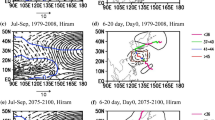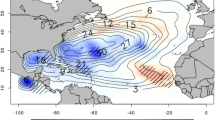Abstract
The Weather Research and Forecasting (WRF) Model 5-day simulations of Major Hurricane Julia (2010) and Tropical Storm Florence (2012), both of which developed from African easterly waves, are used to conduct a complete energetics study to explain why one storm became a major hurricane while the other weakened to a wave. The disparate intensity outcomes are caused by significant differences in the energetics of the two systems that emerge in their storm stages due to differences in the impact of the Saharan air layer (SAL). In their wave stages both waves exhibit a convectively driven energy production cycle, in which the regions of positive barotropic and baroclinic energy conversion and of diabatic heating and rainfall are all superimposed. Convection induces barotropic instability which then enhances the baroclinic overturning through a resonance of the two instabilities, which together produce the eddy kinetic energy. Diabatic heating in the convection generates eddy available potential energy which, along with the eddy kinetic energy, defines the total eddy energy of the system. Florence loses the convectively driven energy production cycle in the storm stage and begins to weaken, while Julia maintains this cycle and becomes a major hurricane. The disruption of the convection in Florence is due to the drying, stabilizing, and vertical shearing effects of an expansive SAL to the north of the storm, effects not present in the Julia case. Consideration is given to the different effects of the SAL on 6–10 day waves (Florence wave) versus 3–5 day waves (Julia wave).












Similar content being viewed by others
References
Avila LA, Pasch R, Jing J (2000) Atlantic tropical systems of 1996 and 1997: years of contrast. Mon Wea Rev 128:3695–3706
Burpee RW (1972) The origin and structure of easterly waves in the lower troposphere of North Africa. J Atmos Sci 29:77–90
Cangialosi JP (2012) Tropical Cyclone Report, Tropical Storm Florence (AL062012), 3-6 August 2012. National Hurricane Center (nhc.noaa.gov/data/tcr/AL062012_Florence.pdf)
Carlson TN (1969) Some remarks on African disturbances and their progress over the tropical Atlantic. Mon Wea Rev 97:716–726
Carlson TN, Prospero J (1972) The large-scale movement of Saharan air outbreaks over the northern equatorial Atlantic. J Appl Meteor 11:283–297
Cecelski SF, Zhang D-L (2013) Genesis of hurricane Julia (2010) within an African easterly wave: low-level vortices and upper-level warming. J Atmos Sci 70:3799–3817
Cecelski SF, Zhang D-L (2014) Genesis of hurricane Julia (2010) within an African easterly wave: Sensitivity analyses of WRF-LETKF ensemble forecasts. J Atmos Sci 71:3180–3201
Charney JG, Stern M (1962) On the stability of internal baroclinic jets in a rotating atmosphere. J Atmos Sci 19:1165–1184
Chen SH, Wang S, Waylonis M (2010) Modification of Saharan air layer and environmental shear over the eastern Atlantic Ocean by dust-radiation effects. J Geophys Res. doi:10.1029/2010JDO14158
Diedhiou A, Janicot S, Viltard A, de Felice P (1998) Evidence of two regimes of easterly waves over West Africa and the tropical Atlantic. Geophys Res Lett 25:2805–2808
Dunion JP, Velden C (2004) The impact of the Saharan air layer on Atlantic tropical cyclone activity. Bull Amer Meteor Soc 85:353–365
Estoque MA, Lin M (1977) Energetics of easterly waves. Mon Wea Rev 105:582–589
Fjortoft R (1950) Application of integral theorems in deriving criteria of stability for laminar flows and for the baroclinic circular vortex. Geofis Publ 17(6):5–52
Frank NL (1970) Atlantic tropical systems of 1969. Mon Wea Rev 98:307–314
Holton JR (1971) A diagnostic model for equatorial wave disturbances: the role of vertical shear of the mean zonal wind. J Atmos Sci 28:55–64
Hsieh JS, Cook K (2005) Generation of African easterly wave disturbances: relationship to the African easterly jet. Mon Wea Rev 133:1311–1327
Hsieh JS, Cook K (2007) A study of the energetics of African easterly waves using a regional climate model. J Atmos Sci 64:421–440
Hsieh JS, Cook K (2008) On the instability of the African easterly jet and the generation of African waves: reversals of the potential vorticity gradient. J Atmos Sci 65:2130–2151
Karyampudi VM, Carlson T (1988) Analysis and numerical simulations of the Saharan air layer and its effect on easterly wave disturbances. J Atmos Sci 45:3102–3136
Karyampudi VM, Carlson T, Pierce H (2002) Synoptic-scale influence of the Saharan air layer on tropical cyclogenesis over the eastern Atlantic. Mon Wea Rev 130:3100–3128
Kwon HJ (1989) A re-examination of the genesis of African waves. J Atmos Sci 46:3621–3631
Lorenz EN (1955) Available potential energy and the maintenance of the general circulation. Tellus 7:157–167
Norquist DC, Recker E, Reed R (1977) The energetics of African wave disturbances as observed during Phase III of GATE. Mon Wea Rev 105:334–342
Oort AH (1964) On estimates of the atmospheric energy cycle. Mon Wea Rev 92:483–493
Reed RJ, Norquist D, Recker E (1977) The structure and properties of African wave disturbances as observed during Phase III of GATE. Mon Wea Rev 105:317–333
Rennick MA (1976) The generation of African easterly waves. J Atmos Sci 33:1955–1969
Riehl H (1954) Tropical Meteorology. McGraw-Hill, pp 392
Rosenfeld D, Woodley W, Khain A, Cotton W, Carrio G, Ginis I, Golden J (2012) Aerosol effects on microstructure and intensity of tropical cyclones. Bull Amer Meteor Soc 93:987–1001
Schubert WH, Ciesielski P, Stevens D, Kuo H (1991) Potential vorticity modeling of the ITCZ and the Hadley circulation. J Atmos Sci 48:1493–1509
Thorncroft CD, Hodges K (2001) African easterly wave variability and its relationship to Atlantic tropical cyclone activity. J Climate 14:1166–1179
Thorncroft CD, Hodges K, Hoskins B (1994a) An idealized study of African easterly waves. Part I: a linear view. Quart J Roy Meteor Soc 120:953–982
Thorncroft CD, Hodges K, Hoskins B (1994b) An idealized study of African easterly waves. Part II: a nonlinear view. Quart J Roy Meteor Soc 120:983–1015
Zhang H, McFarquhar G, Cotton W, Deng Y (2009) Direct and indirect impacts of Saharan dust acting as cloud condensation nuclei on tropical cyclone eyewall development. Geophys Res Lett 36:L06802. doi:10.1029/2009GL037276
Acknowledgments
This research was supported by National Aeronautics and Space Administration (NASA) Grant NNX12AJ77G.
Author information
Authors and Affiliations
Corresponding author
Additional information
Responsible Editor: M. Kaplan.
Appendix: Energetics equations
Appendix: Energetics equations
[()] represents a zonal mean and \(\overline{{\left[ {\left( {} \right)} \right]}}\) represents a meridional mean of the zonal mean. Primes indicate deviations from the zonal mean, and asterisks indicate deviations from the area mean. The relationships are \(\left( {} \right) = \left[ {\left( {} \right)} \right] + \left( {} \right)^{{\prime }}\) and \(\left[ {\left( {} \right)} \right] = \overline{{\left[ {\left( {} \right)} \right]}} + \left( {} \right)^{*}\). Vaiables not mentioned in the text: K Z is zonal kinetic energy, A Z is zonal available potential energy, C Z represents conversions between the two.
Following are the definitions of variables:
- u :
-
Zonal wind component, positive to the east
- v :
-
Meridional wind component, positive o the north
- ω :
-
Vertical pressure velocity
- T :
-
Temperature
- p :
-
Pressure
- F x :
-
Friction in the zonal direction
- F y :
-
Friction in the meridional direction
- Q :
-
Diabatic heating
- ϕ :
-
Geopotential
- \(\overline{\sigma }\) :
-
Mean static stability (gc −1 p \(\overline{\left[ T \right]}\) - gpR −1 \(\partial \overline{\left[ T \right]}\) ∂ p −1)
- c p :
-
specific heat at constant pressure
- R :
-
Specific gas constant for dry air
- g :
-
Gravitational acceleration
- x :
-
Zonal coordinate, positive to east
- y :
-
Meridional coordinate, positive to north
- L x :
-
Zonal distance for the domain
- L y :
-
Meridional distance for the domain
Rights and permissions
About this article
Cite this article
Ross, R.S., Krishnamurti, T.N. & Chaney, K.M. A comparative study of the role of the Saharan air layer in the evolution of two disparate Atlantic tropical cyclones using WRF model simulations and energetics calculations. Meteorol Atmos Phys 128, 1–22 (2016). https://doi.org/10.1007/s00703-015-0405-1
Received:
Accepted:
Published:
Issue Date:
DOI: https://doi.org/10.1007/s00703-015-0405-1




